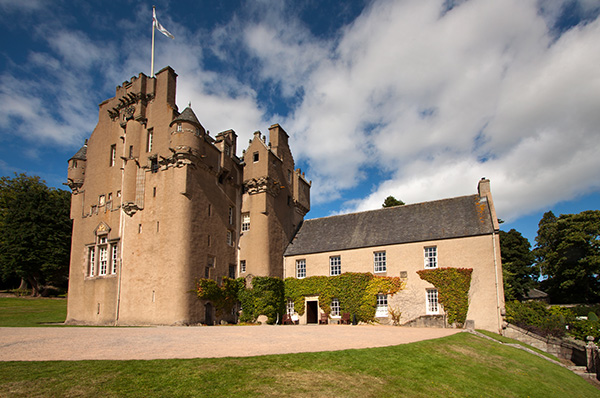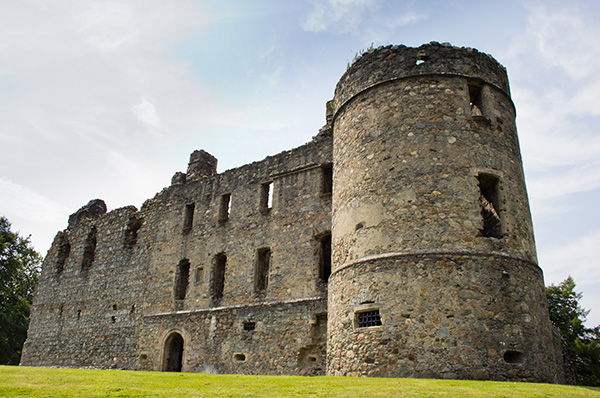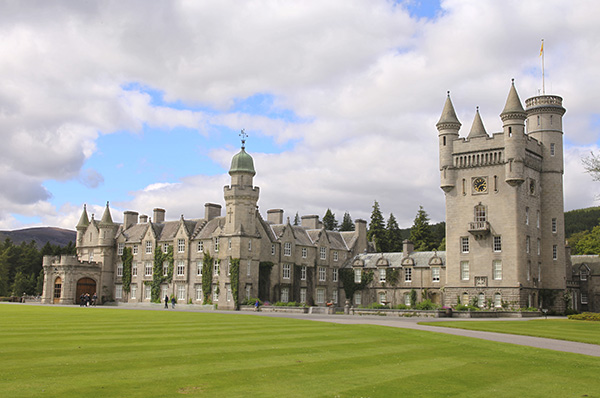Aberdeenshire has more castles per square mile than anywhere else in Britain. With so many complete castles, stately homes and ruins to choose from, the tourist board has designed an itinerary called Scotland’s Castle Trail, which makes a great motorhome holiday.
Although the route is designed to be completed in 6 days, you would have a much more relaxed holiday if you could take two weeks over it, particularly if you’re driving a big motorhome on Scotland’s often narrow and twisty roads for the first time.
Day 1; Dunottar, Crathes, Drum Castle

1. Scotland’s Castle Trail starts at Dunottar Castle is on the southern outskirts of Stonehaven, just south of Aberdeen and easily reached from the south on the A90. This atmospheric ruin sits on a cliff-top 160 feet (50 metres) above the sea and has a long and bloody history. The walk from the car park is steep. If it is too hard for you, you can get very good photographs from the headland to the right of the path – but it would be a real shame not to explore the castle if you can.
2. From Stonehaven take the A957, the “Slug Road”, towards Banchory. A few miles before you reach Banchory you’ll find Crathes Castle, a National Trust for Scotland (NTS) property. (If you plan to complete the Scottish Castles route, it would pay you to take out membership of both the NTS and Scottish Heritage.) A classic pink-painted castle based on a square keep, the present building at Crathes dates from the 16th century and is well-supplied with ghosts, painted ceilings and historical connections. It also has a famous walled garden and way-marked trails through the woods.
3. Drum Castle is 5 miles away to the east, near Drumoak. Drum is earlier than Crathes, with a late 13th century tower surviving, now attached to a Jacobean mansion with Victorian additions – a must for those interested in architecture. There is an ancient oak woodland, a Site of Special Scientific Interest mixed woodland and an arboretum, as well as a walled garden with a collection of historic roses.
Feughside Caravan Park at Banchory is not a Camping and Caravanning Club site but it may offer discounts to members – it’s worth asking. It’s a 5-acre level site so there should be plenty of room for caravans and motorhomes, but it would be worth booking in advance; after a 3-castle day and driving on some quite narrow roads, you probably won’t want to be searching for another campsite!
Day 2; Castle Fraser, Tolquhon Castle, and Haddo House
1. Due north of Banchory as the crow flies lie Sauchen and Castle Fraser, a late 16th century Z-plan castle. Among the family portraits and other memorabilia you can see Charles Mackenzie Fraser’s wooden leg. The walled garden here was not just a pleasure garden: it also grown fruit trees and vegetables. The estate also has mixed woodland, with two paths giving excellent views.
2. Your next stop is Tolquhon Castle (pronounced Tolhoon) at Tarves, a beautiful and impressive ruin dating from the 16th century. It was designed as a fortified home rather than a purely defensive castle but it still has plenty of gun-loops in the outer walls and a secret compartment for valuables above the laird’s room. This property is managed by Historic Scotland and may be closed if the weather is very bad – it wouldn’t be much fun to visit then, anyway.
3. Haddo House is not a castle but a Georgian mansion designed by William Adam in 1732 and refurbished in the 1880s. The interior has many fine antiques and paintings, while outside there’s a geometric terrace garden and a magnificent avenue of lime trees, at the end of which you’ll find Haddo Country Park with lakes, monuments and wildlife all waiting to be explored.
Your best campsite for the night would be the Camping and Caravanning Club’s (CCC’s) certificated camping site, Boggieshalloch, at Turiff, near the first two castles of tomorrow’s route. It is small, with space for a maximum of 5 motorhomes, so early booking is definitely advised.
Day 3; Fyvie Castle Delgatie, and Kinnaird Head Castle
1. Fyvie Castle, south of Turiff, has been added to by each of the five families that have owned it since the 13th century. The oldest part of the castle has a magnificent wheel staircase, there’s 17th century plasterwork on the Morning Room ceiling and the later parts of the building have all the opulence of the Edwardian era (early 20th century). Outside there’s a productive walled garden, a racquets court, ice house, loch, bird hide and many other attractions.
2. North east of Turiff is Delgatie Castle, one of the earliest buildings on the Scottish Castles route: it dates from about 1050. It is still a family home, surrounded by an estate that includes forestry where visitors can walk.
3. The final stop on today’s tour could hardly be more different: Kinnaird Head Castle at Fraserburgh was converted in 1787 to incorporate the first lighthouse in the area. It now houses the Museum of Scottish Lighthouses and it’s well worth spending some time here; Scottish lighthouses are marvels of engineering under extreme conditions.
Some 7 miles south of Fraserburgh is the CCC’s certificated campsite at North Cairnchina, another small site that you should book in advance if you want to be sure of a pitch, especially in summer. If there’s no room there, Wester Bonnyton, Myrus and Banff caravan parks are all on the way to the first of tomorrow’s visits.
Day 4; Duff House, Huntly, Spynie Place, and Balvenie Castle

1. Duff House is a magnificent mansion in Banff, and now an outstation of the National Galleries of Scotland. The building, managed by Historic Scotland, is another of William Adam’s designs. Not only does it display a magnificent collection of paintings, there’s also a stunning collection of furniture and beautiful parkland outside to stretch your legs in.
2. Next stop is Huntly Castle, west of Turiff, is a ruin dating back to the 12th century, with a 16th-17th century palace block that saw action during Scotland’s civil war. The castle is famous for its stone carvings, especially on the fireplaces.
3. Spynie Palace, home of the bishops of Moray for nearly 500 years, is near Elgin. It’s now a ruin but you can climb David’s Tower and look over towards the little city, where the bishops’ cathedral is also now a ruin open to the public.
4. Heading south again, your final stop is Balvenie Castle near Dufftown. It was formerly known as Mortlach Castle and both names will be familiar to whisky lovers. Balvenie is a rare example of 13th century Scottish military architecture, with its impressive curtain wall. The castle was altered over the centuries and has welcomed Mary Queen of Scots, Edward 1 of England and the Marquess of Montrose, among other notable guests. Nearby, you can take a tour of both the Balvenie and Glenfiddich Distilleries, for which pre-booking is highly recommended.
Nearby caravan and camping parks include Aberlour Gardens and Speyside, or you could head to CCC site at Huntly, near tomorrow’s first venue. It has hard-standing for 50 vehicles, so you should be sure of finding a pitch.
Day 5; Leith Hall, Kildrummy Castle, and Corgarff Castle
1. Leith Hall and Garden at Huntly is a NTS property with a fine garden, including a rock garden which is being restored, an 18th century stable block and an ice house. The house is still a family home and is generally considered to be one of the hidden gems of the Trust.
2.Kildrummy Castle, near Strathdon at the edge of the Cairngorms, is the 13th century stronghold of the Earls of Mar. It has a many imposing military features, including a curtain wall and a twin-towered gatehouse. The castle was besieged many times and played its part in the 14th century war of independence (from England) and the 1715 and 1745 Jacobite Risings.
3. Corgarff, south of Strathdon, looks much less dramatic that Kildrummy and is also much more complete, a 16th century tower house surrounded by 18th century star-shaped defences. It was used to house Government troops after the 1745 Jacobite Rising and to control the illegal whisky trade between 1827 and 1831. The bake-house and brew-house are worth visiting too.
Possible camping sites for the night include Ballater Caravan Park and Braemar Caravan Park, both near the official start of tomorrow’s tour. However, you may feel it makes more sense to start with the most northerly of tomorrow’s three sites, near Aboyne, in which case the Aboyne Loch Caravan Park or Tarland Camping and Caravanning would make more sense.
Day 6; Braemar, Balmoral and Craigievar Castle

1. The official start of your final day is Braemar Castle (if you want to start at Aboyne and work south, jut read the route backwards). Braemar has been something of a multi-purpose building: hunting lodge, fortress, barracks and family home. Once the home of the Earls of Mar and of the Farquharson family, the castle dates from 1628 and boasts castellated turrets, a star-shaped curtain wall and a bottle-necked dungeon. 12 furnished rooms are on show to the public.
2. Balmoral Castle, summer home of the Royal family and one the most famous Scottish castles, is only open from March 25th until July 31st in 2016. You can visit the grounds, gardens and exhibition, but not the interior of the castle. If you have more time, you can arrange a safari tour that takes you through the park and up into the mountains to spot wildlife.
3. Craigievar, near Aboyne, is one of Scotland’s prettiest castles, with pink turrets lifting into the sky in true fairytale fashion. The Great Tower was completed in 1626 and the castle was a family home until quite recently and still contains family portraits, Jacobean wood carvings and some unique furniture. You can also visit the Victorian kitchen garden, the Scottish glen garden, and the parkland with its two way-marked walks.
The campsites are the same as those for Day 6; which you choose depends on which way round you did today’s tour and where you are going the following day.
We hope you enjoy your tour of Aberdeenshire castles on the official Scotland’s Castle Trail. There are plenty more castles to choose from if you have time, and a motorhome is a great vehicle from which to explore these historic buildings at your leisure. We’ve barely scratched the surface with how many castles Scotland has to offer, and our next blog will be about the majestic castles of the Scottish Highlands and West Coast.